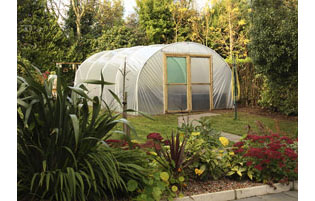 Casting your eye over a garden in full bloom is one of the great thrills for horticulturalists, as you reap the rewards for all your hard work in the form of a colourful, blossoming landscape. However, while a lot of time and effort has gone into such a beautiful creation, you won’t have done it alone.
Casting your eye over a garden in full bloom is one of the great thrills for horticulturalists, as you reap the rewards for all your hard work in the form of a colourful, blossoming landscape. However, while a lot of time and effort has gone into such a beautiful creation, you won’t have done it alone.
That’s because a host of pollinating insects and animals will have given you a helping hand – doing their bit to assist you in producing the garden of your dreams. But what are pollinators, how can you attract them, and which are the best plants for pollinators? Here at Premier Polytunnels, we hope to provide all the answers!
What are pollinators?
Pollinators are insects or other animals that shift pollen from the male part of a flower, the anther, to the female part, the stigma, of the same species. This transfer ensures fertilisation of the flower and encourages fresh growth, while the pollinators themselves also reap the benefits as they receive carbohydrates, proteins and fats from the nectar and pollen. It’s a win-win situation!
What are some examples of pollinating insects and birds?
The most common type among British pollinating insects is the honey bee, although many other species of bees as well as flies, beetles and butterflies also act as pollinators. Additionally, some birds and even bats can help to pollinate your garden, depending on location and plant type.
Which are the best plants for pollinators?
Bees are attracted to a wide range of plants, including wild roses, geraniums, flax, poppies and zinnia while apple and pear trees may also draw them to your garden. Hummingbirds also act as pollinators and they are attracted to begonias, lilies and hollyhocks while the likes of marigolds, calendulas, delphiniums and sage will entice butterflies to your patch.
How to attract pollinators to your garden
There are a few ways you can encourage more pollinating insects and animals to visit your garden:
Stay natural: Try to avoid the use of powerful pesticides when looking to protect your plants and flowers. These can disrupt the natural ecosystem and kill off beneficial organisms, not to mention potentially exposing you and anyone else to harmful chemicals. Try to stay as organic as possible and maintain a natural system, as pollinators will be deterred by the presence of pesticides.
Use pollen-rich flowers: The best way to attract pollinators is to entice them with a range of flowers that are rich in pollen and nectar. Some examples of these include lavender, fuchsias, clematis and hydrangeas, but there are a huge variety to choose from, so you’ll be able to plant those that best suit you and your garden.
Offer a source of water: Pollinating insects and birds all need water to thrive, so it might be worth considering the inclusion of a water feature – perhaps in the form of a bird bath or pond – to encourage them to visit your garden.
Offer shelter: Your pollinators will need a safe place, away from any predators or inclement conditions, so try to include an area of shelter if possible. This can be of the man-made variety, such as a nesting box, while growing hedges or leaving garden waste to rot down offers a more natural, organic solution.
Bring in a beehive: The best and most common pollinators are bees, so why not consider taking up beekeeping to help your flowers blossom? It may require a little patience and learning but, if you’ve got the time and space, using a beehive could really help your garden thrive!